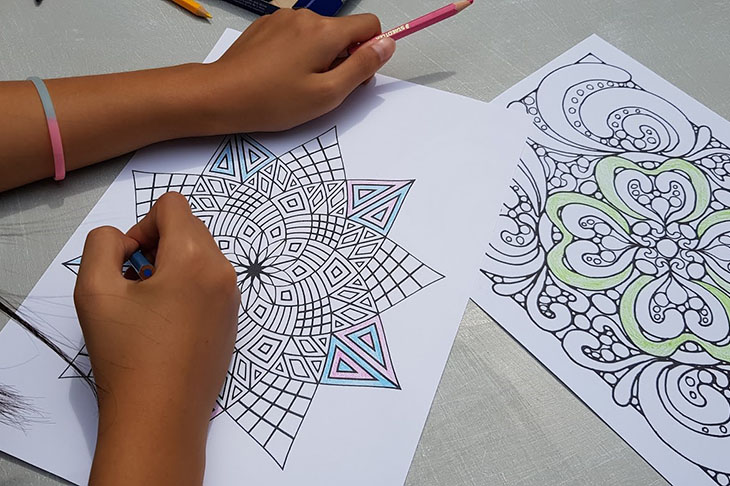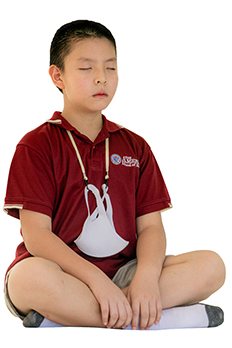A Foundation in Modern Neuroscience
 The training implemented under the Mindful Education Initiative at ASB is based on recent advances in neuroscience and the understanding of brain function. In particular, the idea of neuroplasticity, or the ability of the brain change over time in response to training, has made great advancements to understanding the benefits of mindfulness practice. A key concept from the field of neuroplasticity is “neurons that fire together, wire together”. In other words, the more certain neural pathways are used (such as pathways for anger, for compassion, for happiness, etc), the stronger those neural connections become. Over time, these neural connections become hard-wired into habits. The idea behind mindfulness training is to strengthen neural pathways that lead to beneficial and prosocial behavior (e.g. kindness, patience, empathy, etc.) and weaken the pathways that lead to detrimental and antisocial behavior (e.g. anger, sadness, fear, etc.). Mindfulness practice works by directly tapping into and cultivating these positive qualities (i.e. neural pathways) of the mind.
The training implemented under the Mindful Education Initiative at ASB is based on recent advances in neuroscience and the understanding of brain function. In particular, the idea of neuroplasticity, or the ability of the brain change over time in response to training, has made great advancements to understanding the benefits of mindfulness practice. A key concept from the field of neuroplasticity is “neurons that fire together, wire together”. In other words, the more certain neural pathways are used (such as pathways for anger, for compassion, for happiness, etc), the stronger those neural connections become. Over time, these neural connections become hard-wired into habits. The idea behind mindfulness training is to strengthen neural pathways that lead to beneficial and prosocial behavior (e.g. kindness, patience, empathy, etc.) and weaken the pathways that lead to detrimental and antisocial behavior (e.g. anger, sadness, fear, etc.). Mindfulness practice works by directly tapping into and cultivating these positive qualities (i.e. neural pathways) of the mind.
Three Pillars of Mindfulness
The ASB Mindful Education Initiative curriculum is based on our Three Pillars of Mindfulness:
- Non-Judgemental Awareness
This is the basis of all mindfulness practice: being aware of your present moment experience without judging the experience as good or bad; merely observing it with a kind and gentle attention. Another way to think of this quality is having a “non-reactive” awareness of what’s going on in your world. Cultivation of a non-judgemental awareness in students leads to less emotional reactivity, more self-awareness, and a greater sense of calm and patience.
How it’s cultivated: Techniques such as mindful breathing, and mindfulness of thoughts and emotions, with an emphasis on cultivating acceptance of all experiences, whether they are pleasant, unpleasant, or neutral.
Outcomes: Decreased emotional reactivity, increased self-regulation, Increased self-awareness, increased calm, and Increased patience,
 Concentration
Concentration
This is the ability to keep one’s attention on a particular task or subject over a sustained period of time. The ability of students to maintain sustained concentration is becoming less common in the 21st century, particularly as they grow more dependent on mobile devices, social media and email, and are more inclined to multi-task and scatter their attention in different directions. Through mindfulness training, students and teachers become less prone to daydreaming and procrastination and become more efficient at completing work and connecting to the task at hand.
How it’s cultivated: Any technique of mindful awareness with the added dimension of training the mind to return to the subject of awareness whenever the attention drifts away. Mindful breathing, counting breaths, and using the belly as an anchor are all great techniques for increasing concentration.
Outcomes: Increased focus, increased efficiency, decreased daydreaming/procrastinating, and increased engagement with tasks
- Compassion and Empathy
These are the aspect of mindfulness that is kind, gentle, and caring. Without including this important quality of the heart, mindfulness has the potential to feel cold or indifferent. Compassion and empathy help students and teachers cultivate greater kindness, sympathetic joy, and equanimity. This becomes increasingly important when faced with difficult situations, or while experiencing negative emotions such as anger, sadness, stress, or fear. Often, a direct antidote for difficult emotions is to practice the various trainings in heartfulness. Recent studies have shown that training students in self-compassion have a great impact on overall mental health and academic engagement.
How it’s cultivated: Specific mental exercises and visualization techniques that elicit kindness and warmth in the mind. One example of this training is repeatedly sending out thoughts of well-being and kindness to others and to ourselves. This begins to strengthen neural pathways in the brain that are associated with kindness, eventually leading to new habit formation. Other exercises may similarly elicit sympathetic joy or equanimity in the same way.
Outcomes: increased kindness, compassion, sympathetic joy, equanimity, empathy, and resilience.
1.7.3 How is Mindfulness Implemented at ASB?
- Grades 1 - 5: In-classroom mindfulness (once per week); Weekly practice activity at the Wednesday assembly; Group training once every two months.
- Grades 6 - 8: Mindfulness training during Got 20 (optional); In-classroom mindfulness (at teacher’s request); Group training once every two months.
- Grades 9 - 12: Mindfulness training during Got 20 (optional); Mindful Studies - an elective course for high school students; Group training once every two months.
Additional mindfulness opportunities include:
- Mindfulness Training for teachers and staff
- Mindfulness Training for parents
- Mindfulness counseling for parent/student (at Principal’s discretion)






